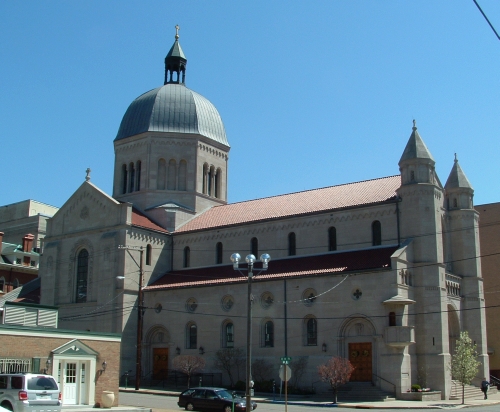Geoff Yovanovic teaches the Architectural Design course in the Master’s in Sacred Art. He describes the work of an architect who worked around the turn of the last century and looked to the Romanesque for inspiration. This was at a time when many of his contemporaries were designing gothic revival. Geoff writes:
Numbered among the great American architects of the early 20th Century, Edward Joseph Weber built many beautiful ecclesiastical buildings throughout Appalachia. From his office in Pittsburgh, Weber designed traditional English and French-inspired parish churches throughout industrial towns in West Virginia, Pennsylvania, and Ohio. While not as well-known as his contemporary Ralph Adams Cram, Weber’s buildings achieved the same level of refinement and beauty as Cram’s cathedrals. While Cram’s wealthy clients awarded him the opportunity to explore the ornate details of the English Perpendicular Gothic, Weber’s blue-collar clients had to settle for more modest church buildings. He had to rely upon his keen sense of proportion, massing, and the choice of economical materials to achieve beauty on a budget. Without the elaborate details, Weber was able to achieve this balance by exploring the small English parish churches and Romanesque churches of Normandy.
In addition to his built work as an architect, Weber is also remembered for his book Catholic Ecclesiology. It is similar Contrasts by A.W.N. Pugin in the early 19th century. Pugin, an Englishman, was the leader of the Victorian gothic revival movement and his book was a well-known indictment of the ‘sham’ architecture of Victorian England. Like Pugin, Weber criticized the church building practice of his day. Weber’s pointed criticism may come as a surprise to many readers who see the churches of the early 1900s as the benchmark for American church architecture. Stemming from a deep understanding of traditional design and proportion, he criticized the countless oversized, squat, and disproportionate churches built of thin, flimsy, and cheap materials. Unlike a withdrawn architectural critic, Weber drew from his own experiences of working with modest budgets in blue-collar towns. He also took aim at the guiding principles of church building committees.
“The building committee must have intimated that they would have “no silly following of European Catholic church precedent, as they were not living in the Middle Ages; this is the twentieth century, forsooth, and in this modern age, everything must be light, airy, unobstructed.” Accordingly, no attempt was made to reflect the beauteous styles of the Ages of Faith.”
He saves his sharpest criticism for the ‘colonoclasts’ who did not “wish columns to obstruct the view of even the tiniest bit of the altars. “There could be no place for the publican to stand within the shadow of a column and cry, ‘O Lord be merciful to me a sinner.’”
Weber’s principles of church architecture can be seen in his masterful Saint Joseph Cathedral in Wheeling, West Virginia. The church is a Norman-Romanesque church whose proportion and scale create an imposing presence. He caps the nave and transept crossing with a dome inspired by the Florentine Duomo. The details, particularly, the carvings are minimal, but well done in my opinion. The vibrant murals were painted by Felix B. Lieftuchter. Inspired by the art and colors of Mexico, the artwork provides a welcome contrast to the smoke and mist of Appalachia.


If there is to be a renaissance of church architecture in America, I suggest that the writings of Edward Joseph Weber should be used as a guide. Just as in his day, the greatest threat to an architectural revival today is the kitsch architecture which apes intelligent, studied and beautiful designs. The contrast between traditionally inspired art and the increasingly duller attempts at shock and innovation is clear. It is more of a challenge to cultivate a refined taste that recognizes right proportion, appreciates real materials, and demands beautiful work. Weber recognizes both that church communities desire beautiful work, but that they must also work within a budget.
“Every church should be as good as the brain and hand of man can make it, while keeping the cost within the means of the parish. Have a great regard for proportion, silhouette, mass-effect and simplicity in composition and keep away from false construction and false materials.”
